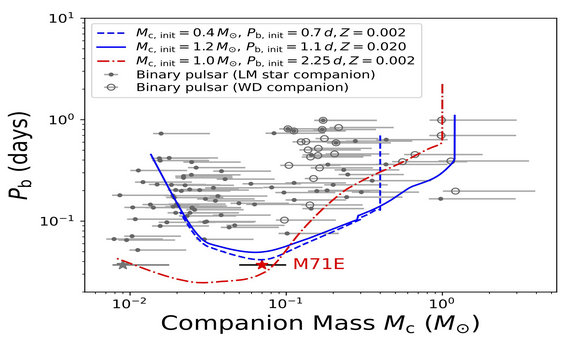FAST finds the missing link in the evolution of the spider pulsar system

Picture of M71E (the pulsar binary on the right of the figure),FAST(on the bottom of the figure) and the globular cluster M71 (background).(Credit: ScienceApe/CAS/NAOC)
The international academic journal Nature published online in the form of Accelerated Article Preview, on June 20, 2023, a research result led by a research group from the National Astronomical Observatories of the Chinese Academy of Sciences (NAOC). The research team used FAST to discover a pulsar binary named PSR J1953+1844 or M71E (Figure 1) with a 53-minute orbital period, filling the gap in the evolution of spider pulsar systems.
The first pulsar was discovered in 1967 by English astronomer Jocelyn Bell, and always rotate regularly and quickly as spinning tops in the sky. The discovery was awarded the Nobel Prize in Physics. It is more than fifty years since its discovery. About 3,000 of these fascinating objects have been founded.

Figure 1: Left panel:the red arrow indicates the location of M71E, next to the globular cluster M71; Right panel: average pulse profile and polarization position angle of M71E in FAST observations. (Credit: Left: Xing Gao; Right: Pan et al. 2023)
Some pulsars locate in binary systems, orbiting with their companion stars. If the two stars are close together, astronomers predicted that the pulsar will swallow up material from the companion star to keep spinning up. At the beginning, the companion star is heavy. As the pulsar eats this star, the two stars get closer and orbit each other with increasing rate. When the star gets lighter after mass loss, the pulsar can't continue to plunder. Then the pulsar pushes the star away, and the orbiting speed becomes slower. This behavior is similar to that female spiders eat male spiders to feed themselves, thus astronomers named the objects in these two stages after two types of spiders: redback and black widow. They are collectively known as spider pulsar.
The evolution from the redback to the black widow takes a long time, up to hundreds of millions of years. Previously, only pulsar binary systems in two states, red back and black widow, had been detected, but no intermediate state between them had been found. The reason is that the orbital period of the intermediate pulsar predicted by this theory is very short and the distance between the two stars is very close, then the observation faces many challenges. Therefore, the theory of the evolution of spider pulsar systems from red back to black widow has not been fully confirmed.
Now, the possibility of this evolutionary path is confirmed by the FAST, the world's largest and most sensitive radio telescope. The research team used FAST to detect the spider pulsar system in a shortest orbit ever discovered. The orbital period of this system was determined to be only 53 minutes after long-term observations. Based on the various indications in the observations, it is determined to be in the intermediate state on the evolution path from the red-back to black widow system, filling in the missing link in the spider pulsar evolution theory (Figure 2). At the same time, the orbital of the binary is almost face-on, such a system is extremely rare. FAST found it in the vast sea of stars with extremely high detection capabilities, filling the gap in the evolution of spider pulsar systems, reflecting its unprecedented sensitivity.

Figure 2: The position of M71E on the orbital period-mass diagram of the companion star. Both the red and blue curves represent the paths of the theoretical simulations of binary star evolution. M71E locatesat an intermediate state of evolution. (Credit: Pan et al. 2023)
The reviewers in the journal Nature described the result as a very interesting pulsar binary system. This discovery shortens the record for the shortest orbital period of a pulsar binary system by about 30%, indicating a new and unknown process in the evolution of spider pulsars.
Co-first authors of the paper are PAN Zhichen and LU Jiguang from the FAST group of NAOC, and CHEN Hailiang from the Yunnan Astronomical Observatories. Corresponding authors are JIANG Peng and HAN Jinlin, researchers from NAOC, and ZHANG Bing, professor at the University of Nevada. This work has collaborators from Guizhou University Guizhou Radio Astronomical Observatory, Yunnan Astronomical Observatory, Shanghai Astronomical Observatory, National Time Service Center, Peking University, University of the Chinese Academy of Sciences, Max Planck Institute in Germany, and University of Nevada Las Vegas.
This work was supported by the Chinese Academy of Sciences Project for Young Scientists in Basic Research, National Key Research and Development Program of China, National Science Foundation of China, the Chinese Academy of Sciences Project for scientific instruments, and the Youth Innovation Promotion Association of Chinese Academy of Sciences.
This paper can be accessed on June 20, 2023, at https://www.nature.com/articles/s41586-023-06308-w
Media Contact:
Prof. XU Ang
Email: annxu@nao.cas.cn
Web: http://nao.cas.cn